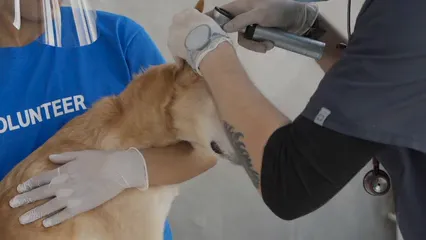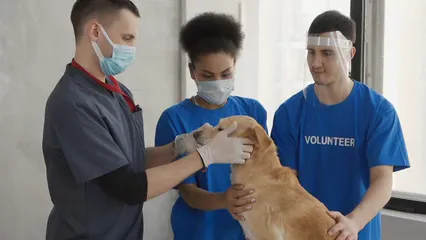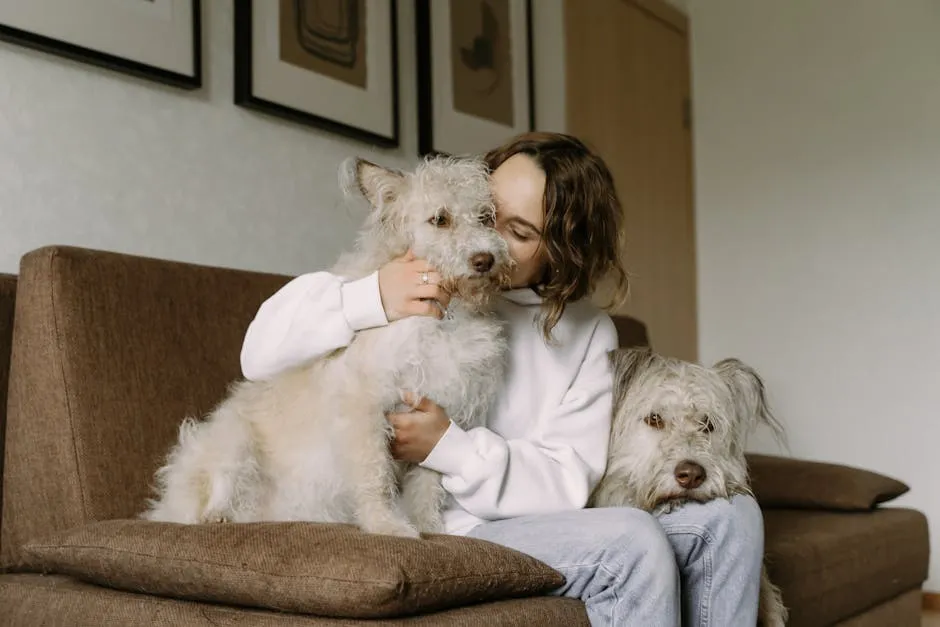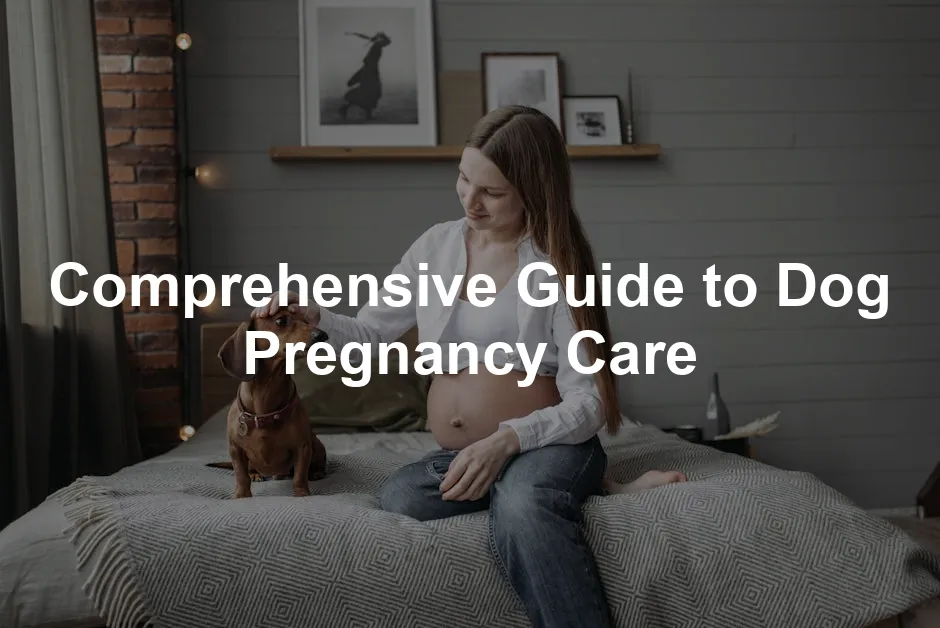Dog pregnancy is both an exciting and crucial time. Caring for a pregnant dog ensures her health and the well-being of her puppies. Proper care during this period is essential for a successful delivery and healthy pups. This guide covers vital aspects of dog pregnancy care to help you navigate this journey.
Summary and Overview
The average duration of dog pregnancy is about 63 days. Recognizing common signs of pregnancy is essential for early intervention and care. Regular veterinary check-ups are crucial to monitor the health of both the mother and her unborn puppies. Nutritional needs change significantly during pregnancy, requiring a proper diet to support growth. Preparing for whelping and postpartum care is vital for the well-being of both mother and puppies. Key points discussed in the article include signs of pregnancy, veterinary care, dietary needs, and preparation for delivery.

To ensure your pregnant dog’s comfort and health during this time, consider investing in a whelping box. This will provide a safe and comfortable space for her to give birth, ensuring a smoother delivery process.
Understanding Dog Pregnancy
How Long Are Dogs Pregnant?
A dog’s gestation period typically ranges from 57 to 72 days. Most dogs will deliver around the 63-day mark. Factors influencing pregnancy duration include breed and litter size. On average, smaller breeds may have smaller litters, while larger breeds may give birth to more puppies. Understanding these factors can help you prepare for the arrival of the new pups.

Signs of Dog Pregnancy
Is your furry friend acting a bit different? Early signs of dog pregnancy can be subtle but important to notice. You might see changes in appetite. Some dogs become hungrier, while others may eat less than usual. Behavior can also shift. You may find her more affectionate or even a bit irritable.
Physically, watch for weight gain. A swollen abdomen is another common symptom. As the pregnancy progresses, you’ll notice her nipples enlarging. These changes can indicate she’s getting ready to nurse.
However, it’s essential to remember that these signs can also indicate other health issues. To confirm a pregnancy, a visit to the veterinarian is crucial. Your vet can provide the necessary tests to ensure everything is on track.
Veterinary Care During Pregnancy
Importance of Regular Vet Visits
Regular veterinary visits are key during your dog’s pregnancy. Your veterinarian plays a vital role in monitoring her health. They can detect any potential issues early on, ensuring your dog and her puppies stay healthy.

Diagnostic tests are often used to confirm pregnancy. An ultrasound can show fetal heartbeats as early as three weeks after breeding. Blood tests can also measure hormone levels, confirming pregnancy around the same time.
In addition to confirming pregnancy, your vet will monitor fetal health. It’s essential to ensure that vaccinations are up to date and that any necessary parasite control is managed. Keeping your dog healthy during this time is a priority.
Preparing for Delivery
As your dog approaches her due date, prenatal check-ups become increasingly important. Generally, you should schedule these visits every few weeks. Discuss any concerns with your vet during these check-ups.
If you notice unusual behavior or signs of distress in your dog, don’t hesitate to reach out to your veterinarian. Addressing complications early can make all the difference in ensuring a smooth delivery.
Being proactive and well-informed will help you support your dog through this exciting yet critical phase of her life.
Nutrition for a Pregnant Dog
Dietary Needs
Transitioning your pregnant dog to high-quality puppy food is crucial. This change should happen around the fifth week of her pregnancy. Puppy food is richer in nutrients and calories, which supports her growing puppies. As pregnancy progresses, her caloric intake needs to increase significantly, particularly in the last trimester. By this point, she may require up to 50% more calories than before.

However, be cautious with supplements. Most dogs on a balanced diet don’t need extra vitamins or minerals. Over-supplementing can lead to health issues. Always consult your veterinarian before adding anything to her diet.
Feeding Schedule
Establishing a consistent feeding routine is essential for your dog’s health. Regular, smaller meals work best, especially as her belly expands. This approach helps with digestion and reduces the risk of nausea. Aim for three to four meals a day, adjusting portions as needed to meet her increased nutritional demands. Keeping her satisfied and comfortable will set the stage for a healthy pregnancy.

For added convenience, consider using a dog food storage container. This keeps her food fresh and accessible, making feeding time a breeze!
For more information on creating a proper raw feeding schedule for your pregnant dog, check out our comprehensive guide.
Exercise and Health Management
Exercise Guidelines
Exercise is important for maintaining your pregnant dog’s health. However, you should limit strenuous activities. Regular, gentle walks are ideal, helping her stay fit without overexerting herself. Aim for shorter walks as she approaches her due date. These walks can help reduce stress and provide mental stimulation too.

Additionally, mental exercises are beneficial. Consider interactive dog toys or gentle training sessions to keep her engaged. This balance of physical and mental activity will ensure she remains healthy throughout her pregnancy. Always monitor her energy levels and adjust the routine based on her comfort.
Monitoring Health
It’s crucial to keep a close eye on your pregnant dog. Look for signs of complications that could need immediate veterinary attention. If you notice excessive vomiting, lethargy, or unusual discharge, call your vet right away. These could indicate serious issues like infection or distress. Another red flag is a drop in temperature more than 24 hours before labor starts without any signs of delivery.

Creating a calm, stress-free environment is essential. Loud noises and chaos can increase anxiety for your dog. Set up a quiet area where she feels safe and secure. You can also minimize interactions with unfamiliar people and pets during this time. This peaceful environment helps promote a healthy pregnancy and lowers the risk of complications.
Preparing for Whelping
Creating a Whelping Space
Preparing a comfortable and quiet whelping area is vital for your dog. Choose a secluded location in your home, away from daily activities. A whelping box is essential and should be spacious enough for her to move around. Line it with clean towels or old blankets for comfort. Make sure the area is warm, as newborn puppies cannot regulate their body temperature well.
Gather necessary supplies for the whelping box. You’ll need clean towels for drying puppies, a heating pad to keep the area warm, and disposable pads for easy cleanup. Having sterile scissors and dental floss on hand can also be useful for cutting umbilical cords if needed.
Whelping Process
Understanding the whelping process will help you support your dog. Labor typically has three stages. The first stage involves contractions and the cervix dilating, lasting around 6 to 12 hours. Your dog may become restless and exhibit nesting behavior during this time.
The second stage is when the puppies are born. Each puppy usually arrives every 45 to 60 minutes, but breaks of up to four hours can occur. After each birth, the placenta is expelled. Keep an eye on your dog during this time; if she seems to struggle or if more than two hours pass without a puppy, contact your veterinarian.
The third stage involves the expulsion of the placenta. It’s crucial to ensure each puppy is nursing and that the mother is caring for them. If she seems disoriented or exhausted, assist her gently. Your presence can provide comfort to both the mother and her new puppies as they begin their lives together.
Postpartum Care
Caring for the Mother
After giving birth, your dog needs careful attention. Recovery is essential for her health. Ensure she has a quiet, comfortable space to relax. This will help her regain strength.

Nutrition plays a vital role during this time. Offer high-quality puppy food, as it’s richer in nutrients. Increase her intake gradually, especially as she nurses her puppies. A nursing dog may require up to four times her usual caloric intake. Fresh water should always be accessible.
Be vigilant and monitor her health closely. Look for signs of complications, such as fever or unusual discharge. If you notice anything concerning, contact your veterinarian immediately. Early intervention can prevent serious issues.

Socialization with her puppies is crucial. She will instinctively care for them, but your interaction helps too. Spend time with her and the pups to foster bonding and ensure a calm atmosphere. This interaction also aids in the puppies’ development.
Caring for Newborn Puppies
Newborn puppies require special care and attention. Keep their environment warm and dry, as they cannot regulate their body temperature. A temperature of around 85°F is ideal for the first week.

Watch their feeding patterns closely. Puppies should nurse frequently, ideally every two hours. Ensure each puppy is gaining weight daily. If any puppy seems weak or is not nursing, consult your veterinarian for guidance.
Limit handling of the puppies during their first few weeks. This helps reduce stress for both the mother and her pups. As they grow, you can start introducing them to new experiences gradually.
Monitoring their growth is key. Keep a record of their weight and health to track their development. If you notice any concerns, such as lethargy or poor weight gain, reach out to your vet. Early detection of issues can lead to better outcomes.
Conclusion
In summary, postpartum care is critical for both the mother and her puppies. Proper nutrition, monitoring health, and socialization are essential components. Always consult your veterinarian for personalized advice and care throughout this journey. Being proactive ensures a happy, healthy transition for your dog and her new family.

If you’d like more resources, consider downloading our checklist for dog pregnancy care. Share your experiences in the comments below!
And don’t forget to check out some wonderful dog calming treats to keep your dog relaxed during her pregnancy.
Please let us know what you think about our content by leaving a comment down below!
Thank you for reading till here 🙂
All images from Pexels





